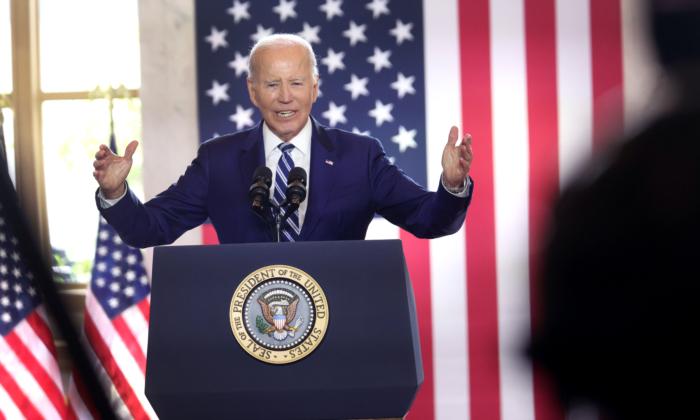President Joe Biden pitched his economic plan in a major address in Chicago, trying to persuade Americans that his strategy is producing record-breaking job creation and investment despite widespread discontent over his handling of the economy.
Biden is attempting to define his economic strategy, termed “Bidenomics,” as a substantial departure from the “trickle-down” economic model that he claims his predecessor, President Donald Trump, has followed.
He has repeatedly said that his vision is to rebuild the economy from the bottom up and the middle out—not the top down—with a focus on the middle class.
“This vision is a fundamental break from the economic theory that has failed America’s middle class for decades now,” Biden said during his speech.
“I came into office determined to change the economic direction of this country, to move from trickle-down economics. Bidenomics is just another way of saying, ‘Restore the American Dream,’ because it worked before.”
His economic plan is already delivering for the American people, he claimed, citing his legislative victories as having created 13 million new jobs, including 800,000 manufacturing jobs, and $490 billion in private-sector investment.
“My predecessor enacted the latest iteration of a failed theory: tax cuts for the wealthy,” Biden said, noting that the estimated cost of tax reform was $2 trillion.
Trump was quick to respond, issuing a statement on June 28 criticizing Biden’s economic policies.
Bidenomics Versus Reaganomics
During his speech, Biden explained how he adopted the new term “Bidenomics” for his economic message in the 2024 campaign.He said he was unaware of it but that journalists had used that name for his economic plan.
“I didn’t come up with a name. I really didn’t. I now claim it, but they’re the ones who used it first,” Biden said.
The White House has lately begun to use this term to rebrand Biden’s economic plan for the 2024 election and to distinguish it from Reaganomics.
“Reaganomics,” the term used to describe President Ronald Reagan’s economic policies, was labeled trickle-down economics by his opponents. Reagan’s plan resulted in an unprecedented economic boom in the 1980s, which helped him achieve a 63 percent approval rating by the end of his presidency.
Reagan’s policy centered on lowering taxes on companies and the wealthy in order to encourage investment and benefit society as a whole. His economic ideas were markedly different from those of Presidents Lyndon B. Johnson and Richard Nixon, both of whom sought to expand the role of the government in the economy. Reagan’s goal was to increase economic activity by reducing dependence on the government.
Biden claimed that because of the trickle-down economic plan, all good jobs were sent overseas.
“We actually have a tax policy that encourages them to go overseas to save money,” he said.
‘Investing in America’ Tour
Biden’s speech in Chicago was part of his second “Investing in America” tour around the country, attempting to convey to Americans how his economic strategy has generated investments and employment.The administration kicked off the week with the announcement of more than $40 billion in infrastructure investment to provide cheap high-speed internet in areas where it’s unavailable or too slow. He likened the investment to President Franklin D. Roosevelt’s plan to bring electricity to every U.S. home and farm through his Rural Electrification Act.
“I can honestly say I’ve never been more optimistic about America’s future. I swear to God. I’ve never been more optimistic,” Biden said in Chicago.
The “Investing in America” tour comes at a time when the economy is still the most pressing issue for Americans. Numerous polls reveal that voters are skeptical of Biden’s upbeat economic message. Concern over inflation and a general dissatisfaction with the economy persist among Americans across the political spectrum.
Biden has also come under fire for his son’s tax avoidance, even though he has fiercely campaigned for the wealthy to pay their “fair” share of taxes.
A recent op-ed by The Wall Street Journal editorial board states that the two whistleblowers who testified before the House Ways and Means Committee “revealed details of Hunter’s tax maneuvering that make a mockery of his father’s tax moralizing.”
Still, the White House has stated that the president’s economic messaging will change people’s perceptions of how he handles the economy.
“We have the numbers to show that his economic policy has indeed worked,” White House press secretary Karine Jean Pierre told reporters on June 26.
“We believe Reaganomics doesn’t work. We’ve been very clear.”
When asked whether the White House is confident that it can change the public’s view of the economy, she said, “We’re going to try.”
During the three-week tour, Vice President Kamala Harris, First Lady Jill Biden, Cabinet members, and senior administration officials will also travel around the country to support Biden’s economic agenda in a bid to bolster his low approval ratings.
According to the White House, Biden’s economic vision is built on three pillars: focusing on “smart” public investments that can attract more private sector investment, empowering and educating workers to expand the middle class, and increasing competition to lower costs for consumers.





